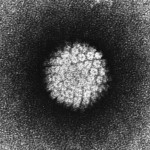HIV positive girls did not respond as well to the quadrivalent human papillomavirus (HPV) vaccine as HIV negative girls of the same age, but they responded as well as HIV negative older women, probably giving them sufficient protection from infection, according to a late-breaker presentation at the recent IDWeek conference in San Francisco.
Human papillomavirus can trigger abnormal cell proliferation and cause warts, tissue abnormalities (dysplasia or neoplasia), and malignancies including cervical and anal cancer.
The bivalent Cervarix vaccine protects against cancer-causing HPV types 16 and 18. The quadrivalent Gardasil vaccine protects against 16 and 18 as well as wart-causing types 6 and 11. HPV vaccines are recommended for girls and boys ages 9 through their mid-twenties. Most people become infected with HPV soon after they become sexually active, so vaccination is recommended by adolescence.
People with HIV who have substantial immune system damage may not produce as many antibodies in response to vaccination, but this has not been extensively studied in relation to HPV. It is an important issue because HIV-positive women and men have higher rates of HPV infection, dysplasia and cervical and anal cancer. Cervical cancer is considered an AIDS-defining condition and many experts think anal cancer should be as well.
Deborah Money from the University of British Columbia conducted a study to evaluate the efficacy of a HPV virus-like particle quadrivalent vaccine in HIV positive girls and women. (Funding was provided by Merck, which makes Gardasil.)
Among HIV negative people HPV vaccination is most effective for adolescents ages 9 to 13, and more than 99% of females and males achieve adequate antibodies after the standard three doses, the researchers noted as background.
This open-label multicenter study enrolled 407 HIV positive female adolescents at 11 sites in Canada between November 2008 and December 2012. Almost all were exposed to HIV through mother-to-child transmission. Most participants were in the 9 to 13 age group (mean 11 years) but 27 were younger; most had not yet started menstruation. The majority (70%) were African-Canadian, 4% were white, and 26% where „other.“
Two-thirds of participants had undetectable HIV viral load at baseline. The mean baseline CD4 T-cell count was 710 cells/mm3 and the nadir (lowest-ever) level was 470 cells/mm3, indicating well-preserved immune function. All but 1 tested negative for the 4 HPV types in the vaccine (6, 11, 16 and 18) at baseline.
An HIV negative comparison group included 825 girls and women ages 9 to 13 or 16 to 26 in another study comparing 2 versus 3 vaccine doses. In that study most participants (80%) were white and 18% were Asian.
The HIV positive girls received 3 vaccine doses, first at study entry with boosters at 2 and 6 months later; follow-up continued for 2 years.
Results
- All HIV positive girls in the study completed the full vaccine schedule.
- All experienced seroconversion, or production of antibodies against all HPV types in the vaccine.
- The overall response rate for the entire cohort was 99%.
- Girls with HIV viral suppression achieved 2- to 3-fold higher antibody titers than those with unsuppressed HIV, but there were few girls in the latter group and differences did not reach statistical significance.
- There were no differences in vaccine response according to baseline or nadir CD4 count.
- HIV positive girls had significantly lower geometric mean antibody titers (GMT) than HIV negative girls ages 9 to 13 in the comparison study for all 4 HPV types at months 7 and 24:
o Month 7:
- HPV type 6: GMT 844 for HIV positive vs 1856 for HIV negative ages 9 to 13;
- HPV type 11: 971 vs 2086;
- HPV type 16: 4924 vs 7595;
- HPV type 18: 703 vs 1706.
o Month 24:
- HPV type 6: GMT 79 for HIV-positive vs 359 for HIV negative ages 9 to 13;
- HPV type 11: 79 vs 422;
- HPV type 16: 524 vs 1739;
- HPV type 18: 41 vs 267.
- Looking at the older HIV negative women (ages 16-26), however, antibody levels were similar and difference were not significant for any HPV type:
o Month 7:
- HPV type 6: GMT 844 for HIV positive vs 944 for HIV negative ages 16-26;
- HPV type 11: 971 vs 1277;
- HPV type 16: 4924 vs 3649;
- HPV type 18: 703 vs 665.
- The quadrivalent vaccine was safe and well tolerated by HIV positive girls.
- No serious adverse events considered related to the vaccine were reported.
In this study there was a „high rate of seroconversion seen in HIV positive girls given the quadrivalent HPV vaccine by standard dosing,“ the researchers concluded. „Lower peak GMT was observed in these HIV positive girls compared to HIV negative girls.“
However, they continued, „levels of response were comparable to levels seen in older women for whom data is available that these levels confer efficacy against HPV infection and disease.“
They cautioned that „until an immune correlate of protection is defined in HIV negative and HIV positive persons, understanding of the meaning of antibody levels remains limited,“ and „the role of booster dosing remains to be evaluated.“
Although this study looked only at HIV-positive girls, the trend in HPV vaccine research over the past several years has been that similar results are seen in boys and men.

